Hoka One One Carbon X2
Test Locations: Logan, UT
Test Duration: 52 miles
Stated Stack Height: 41 mm (heel) / 36 mm (forefoot)
Stated Heel-to-Toe Drop: 5 mm
Stated Features:
- Engineered mesh upper delivers breathable comfort
- Gusseted tongue provides lightweight mid-foot lockdown
- Anatomical Achilles construction
- Removable molded EVA sockliner
- Carbon fiber plate delivers a smooth transition through the gait cycle
- PROFLY midsole gives a cushioned landing and propulsive toe-off
- Rubberized EVA outsole provides lightweight ground contact and responsive cushioning
Reviewer: 6’1″, 145 lbs / 185 cm, 66 kg
Size Tested: US Men’s 11.5
Stated Weight per Shoe (US Men’s Size 9): 238 g / 8.4 oz
Blister Measured Weight (US Men’s 11.5):
- Shoes + Laces: 264 g (left) & 264 g (right)
- Insoles: 13 g (left) & 13 g (right)
- Total: 277 g (left) & 277 g (right)
MSRP: $180
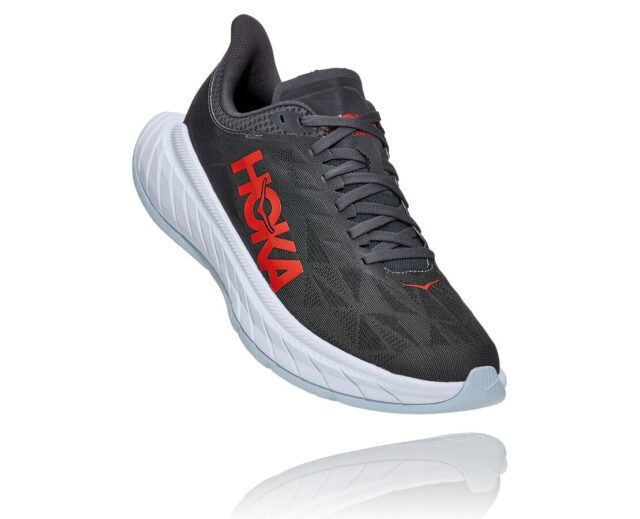
Intro
There’s been a whole lot of buzz — and a fair amount of controversy — around carbon-plated running shoes in the last few years. Ever since Nike debuted their first high-stack-height, carbon-plated marathon shoe (and then had it banned by World Athletics), pretty much every brand has been hopping on the carbon-fiber-plate bandwagon. And while most (ok, pretty much all) of us aren’t trying to get 4% faster to break 2 hours in the marathon, I think it’s fair to say that most runners like the idea of a shoe that makes them more efficient.
At the same time, most carbon-plated shoes really aren’t designed for the “average” runner (at least in my opinion). They’re typically super light, super expensive, and generally pretty race-day-oriented. But what if you’re just looking for an extra-efficient road shoe that’s better suited to both everyday training and racing? Enter the Hoka One One Carbon X2. Sure, the Carbon X2 is fairly performance-oriented — look no further than Jim Walmsley’s recent 100k American Record in the shoe for evidence of that — but Hoka also markets the Carbon X2 as a more cushioned, long-distance shoe.
When we reviewed the original Carbon X, we were impressed by its fast, efficient feel, but still thought it was best suited to a race day and / or workout setting. The Carbon X2 has a higher stack height and (according to Hoka) softer cushioning than its predecessor, so I was curious to see how it would perform across a wider variety of applications. So is the Carbon X2 a true carbon-plated shoe for the masses? After my first 50 miles in the shoe, I think the answer is a pretty strong “maybe.” But of course, there’s more to the story than that, so let’s get into the details.
Hoka One One Carbon X2 vs. Carbon X
I didn’t get a chance to run in the original Carbon X, but Blister reviewer Maddie Hart put about 150 miles on a pair last year — you can check out her full review of the shoe here. As I mentioned in the intro, she was impressed by the Carbon X’s efficient ride and secure fit, but concluded that it was still best-suited for workouts and races.
The Carbon X2 has quite a few changes relative to the previous version that, at least on paper, seem like they have the potential to change that conclusion. First, the stated stack height is 6 mm higher in version two ( 41 mm / 36 mm vs. 35 mm / 30 mm). Hoka also says that the PROFLY midsole foam they’re using in the X2 is softer than the foam used in the previous version. And, as seems to be the trend with most of Hoka’s shoes at the moment, the back of the Carbon X2’s midsole extends a few extra centimeters behind the heel cup — which allegedly gives the shoe a smoother ride. Hoka also tweaked the placement of the shoe’s carbon fiber plate slightly, again with the goal of improving efficiency.

On top of those changes to the shoe’s midsole, the Carbon X2 has an updated upper with an extended heel tab, which Hoka claims improves the fit of the heel cup. And even with the addition of the extra heel tab and extended midsole, the Carbon X2’s stated weight is very slightly lighter than the previous version ( 238 g / 8.4 oz for the X2 vs. 241 g / 8.5 oz for version one). As with the first version of the shoe, Hoka markets the Carbon X2 as an “endurance racer” — but they also describe the X2 with phrases like “plush ride” and “luxurious underfoot feel,” which made me think that the shoe might be good for more than just race day.
Fit
As always, it’s best to try on the Carbon X2 in person, if possible. I’ll provide some background on my experience with the shoe’s fit, but your experience with it might be totally different, depending on your foot shape and fit preferences. Plus it’d probably be good for all of us to go to a running store and actually talk to some real people after living via zoom for the last year.
Anyway, in my experience, the Carbon X2’s fit is both secure and comfortable — with one (potentially major) caveat. But first, the good stuff. The midfoot is extremely secure and comfortable on my fairly low-volume feet — the gusseted tongue holds my foot securely, but everything is stretchy enough to avoid any discomfort. The heel cup is also secure and comfortable. I didn’t run in the first version of the shoe, so I can’t say for sure whether the extended heel tab actually makes the heel cup more comfortable, but I do think that the X2’s heel cup is a little more comfortable than the more standard heel cup on the Hoka One One Rincon 2. So as far as the heel cup and midfoot are concerned, I’ve got no complaints.
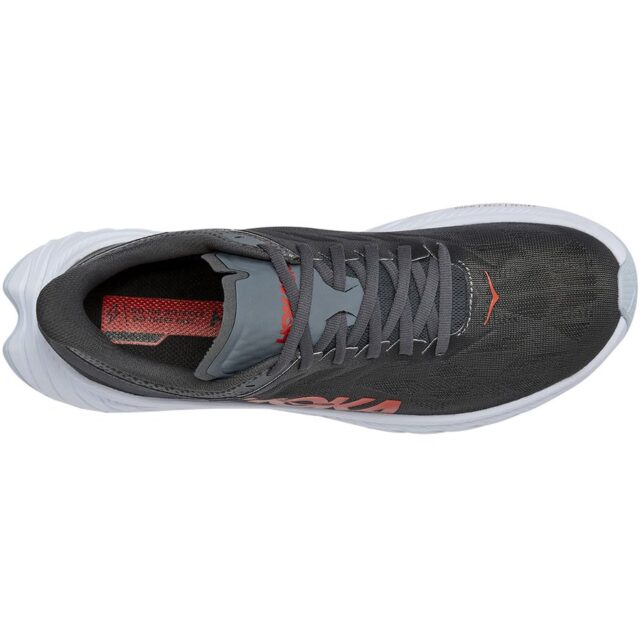
That brings us to the forefoot / toe box. In general, Hoka’s shoes tend to have fairly narrow toe boxes — but the Carbon X2’s toe box seems extra narrow to me. It definitely feels a bit narrower than the toe box on the Rincon 2, which I already considered a fairly narrow shoe. With that said, I personally haven’t run into any issues with the X2’s narrow toe box — probably because of the combination of the shoe’s stretchy mesh upper and my fairly narrow / low-volume feet. For my feet, the Carbon X2 still feels comfortable throughout, and I haven’t had any issues with blisters or hot spots. But if you have particularly wide feet and / or prefer shoes with wide toe boxes, the X2’s narrow toe box definitely seems like it could cause some problems.
Overall, the Carbon X2’s fit feels pretty similar to the Hoka Evo Speedgoat. For my preferences, that’s not a bad thing — I think both shoes are comfortable enough for longer runs, even though they’re pretty narrow. But I also think both shoes would benefit from a wider toe box. If you like narrow shoes, I think you’ll like the Carbon X2. If not, I think you might not be too happy with the shoe’s toe box.
Weight
The Carbon X2 is interesting from a weight perspective in that it isn’t nearly as light as most other carbon-plated road shoes. Then again, most carbon-plated shoes are designed to help the Kipchoges of the world break 2 hours in the marathon, and the Carbon X2 isn’t. I think it’s fairer to compare the X2 to other maximal road shoes that are designed for both training and racing rather than to pure racing shoes like the Nike Alphafly Next%, but I’ll include some of both here for reference (all stated weights are based on a US Men’s Size 9):
210 g / 7.4 oz — Nike Zoom Alphafly Next%
213 g / 7.5 oz — Saucony Endorphin Pro
213 g / 7.5 oz — Hoka One One Rocket X
218 g / 7.7 oz — Hoka One One Rincon 2
230 g / 8.1 oz — Hoka One One Mach 4
238 g / 8.4 oz — Hoka One One Carbon X2
258 g / 9.1 oz — Hoka One One Clifton 7
261 g / 9.2 oz — Altra Torin 4.5 Plush
264 g / 9.3 oz — New Balance Fresh Foam 1080 v11
272 g / 9.6 oz — Topo Athletic Zephyr
So compared to carbon-plated racing shoes like the Saucony Endorphin Pro or Nike Zoom Alphafly, the Carbon X2 might seem kind of heavy. But when you compare the X2 to other high-cushion performance shoes that aren’t specifically designed for racing like the Clifton 7 or Altra Torin 4.5 Plush, it’s pretty similar — if not lighter.
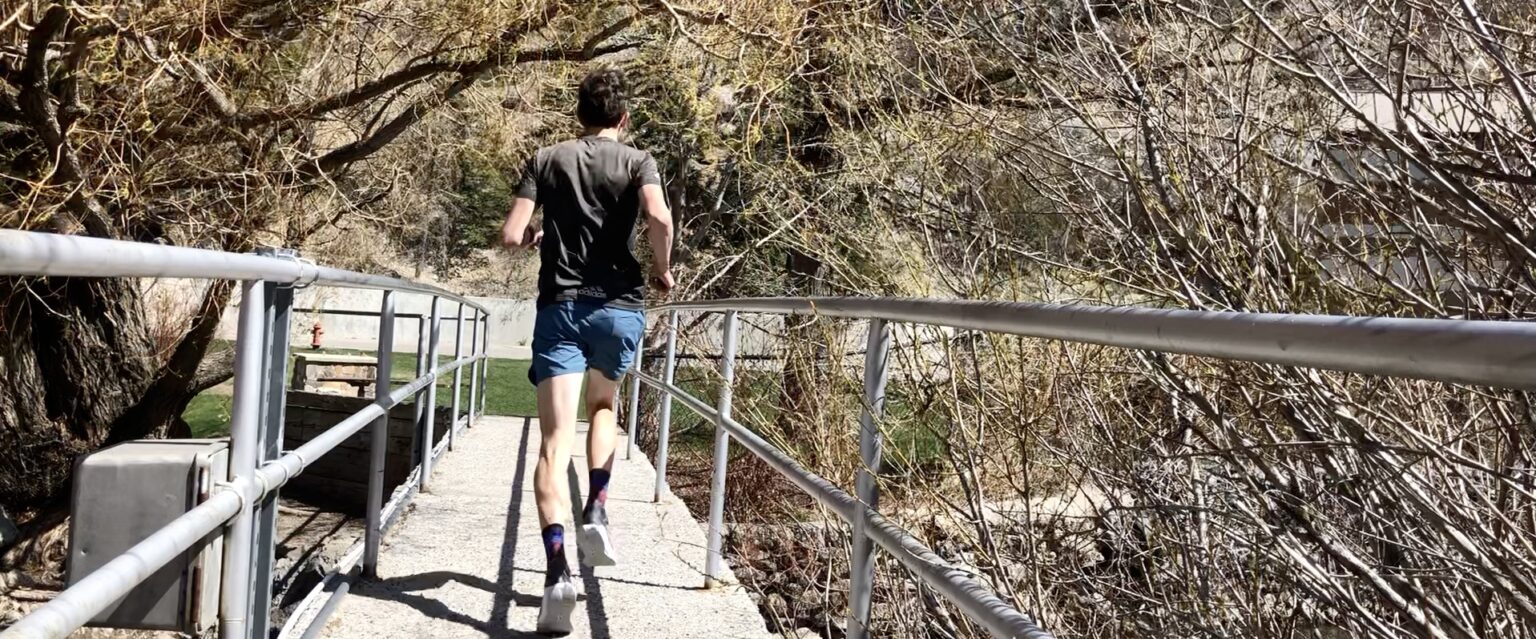
Upper
As I touched on in the Fit section, the Carbon X2’s upper is well designed and effective. It’s made up of a thin, lightweight, stretchy mesh material that’s both comfortable and breathable. The tongue has plenty of padding, as does the heel cup. The sides of the tongue are also anchored to the midsole by elastic gussets, which make for a secure fit through the midfoot. The extended tab on the heel is handy for pulling the shoes on, though I’m still not convinced that it actually improves the fit.
Regardless, the Carbon X2’s upper does its job well in my opinion. I haven’t worn the shoe in any super hot weather yet, but the thin mesh material definitely seems plenty breathable so far. The Carbon X2’s upper also doesn’t feel overly flimsy or thin, so I’m not really concerned about its long-term durability at this point.

Midsole
In my humble opinion, the Carbon X2’s midsole is a true work of art. Most midsoles are either soft and pillowy or energetic and fast. Some shoes manage to land in the middle and offer a mix of cushion and speed, but the Carbon X2 is the only shoe I’ve run in that actually does both at the same time. The carbon plate definitely helps with that, but the rest of the midsole plays an important role, too.
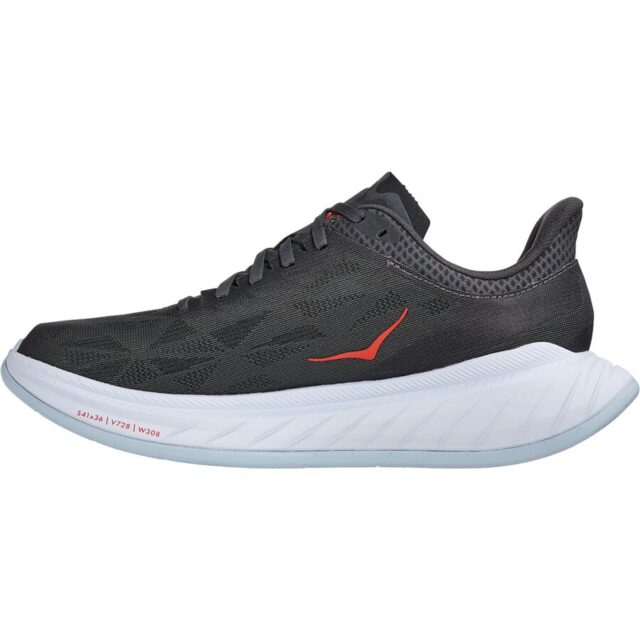
The X2’s midsole has three parts: a thin layer of rubberized EVA foam that doubles as the outsole, a thick layer of Hoka’s fairly soft PROFLY foam, and, of course, the carbon fiber plate sandwiched in between the two foam layers. The net result is a midsole that’s soft and pillowy on top, but has a pretty much rigid bottom layer. And unlike many shoes that boast about their dual- or triple-density midsoles, I can actually feel the two different parts of the X2’s midsole working together out on the road. When my foot first hits the ground, the soft PROFLY foam absorbs the impact and feels surprisingly plush for a performance-oriented shoe. But it gets better — because as you transition and push off, the stiff carbon fiber plate returns that absorbed energy, making for an extremely comfortable and fast ride. So when Hoka says the X2 offers “luxurious underfoot feel,” I pretty much agree.
The one piece of midsole tech that I’m not totally sold on in the Carbon X2 is the extended heel. I know it’s “in” right now, but I honestly don’t think it changes the ride of the shoe in any noticeable way. I don’t think it hurts the shoe’s ride, either, but I’d rather lose the extra few centimeters of midsole and the couple of grams it weighs — if it isn’t doing anything, I don’t see a reason to keep it. But aside from that, I think the Carbon X2’s midsole is pretty awesome.
Outsole
Obviously, outsoles matter a whole lot less on road shoes than they do on trail shoes, and the Carbon X2’s design definitely reflects that fact. Rather than a traditional rubber outsole, the X2 just has a thin layer of rubberized EVA foam with some low-profile texture to provide traction. I was a little concerned that the X2 would be slippery in wet conditions because the outsole looks so smooth compared to the trail shoes I’m used to, but those fears were unwarranted — I’ve worn the Carbon X2 on plenty of rainy, wet runs this spring, and I’ve never worried about slipping.

It is worth mentioning that the Carbon X2’s outsole doesn’t offer quite as much traction on gravel or dirt paths / roads as other road shoes I’ve used. Obviously, the Carbon X2 is designed for pavement, not dirt, but I think it’s even less well-suited to gravel / dirt than shoes like the Hoka Rincon 2 or Altra Torin that have at least some rubber on their outsoles.
On the Road
So far, the Carbon X2 is far and away my favorite road shoe — both for workouts and for easy days. To be fair, I haven’t run in any other carbon-plated road shoes, but the Carbon X2’s feature set seems uniquely versatile compared to more race-specific shoes like the Nike Alphafly Next% or Hoka Rocket X. I attribute most of the Carbon X2’s success and versatility to its midsole. I’ve already ranted and raved about how great I think it is quite a bit, but I think it’s worth mentioning one more time.
In my opinion, the Carbon X2’s unique blend of plush feel and excellent energy return is especially impressive when I compare the X2 to some of my other go-to road shoes. For example, the Hoka Rincon 2 has a fairly firm, efficient-feeling ride that I like for both workouts and longer runs. But the Carbon X2 feels both softer / more comfortable and significantly faster / more efficient than the Rincon 2. The same goes for the Topo Athletic Zephyr — The Zephyr feels fast, but it’s a little too firm underfoot for my preferences on longer days. The Carbon X2 provides way more cushion for longer days, but it also feels much more efficient in a flat-out sprint. Lastly, the Altra Torin Plush is comfortable and soft for long runs, but it can’t touch the Carbon X2 when it comes to efficiency and energy return (at least in my opinion). It’s not all that often that I come across a shoe that does just about everything better than all of my other shoes, but the Carbon X2 comes pretty darn close.
As far as I’m concerned, the Carbon X2’s only limiting factor is its extremely narrow toe box. As I mentioned previously, I haven’t actually had any issues with my toes feeling overly constricted in the X2 — but I’ve also avoided doing any runs longer than about 1.5-2 hours in the Carbon X2 because of its narrow toe box. For runners with wide / high-volume feet, the X2’s toe box will probably be even more problematic. It seems pretty counterintuitive to me that an “endurance” shoe like the X2 that’s specifically designed for long-distance performance would have such a narrow fit — so I’m keeping my fingers crossed that the Carbon X3 gets some extra toe box width when it comes along.
Durability
Obviously, I can’t say much about the Carbon X2’s long-term durability after only 50 miles, but so far everything is holding up well. The upper looks the same as it did out of the box, and the midsole hasn’t lost any of its cushion. The rubberized EVA outsole has worn down a tiny bit, but that’s not too surprising since it’s basically just slightly reinforced foam. At this point, I fully expect the X2 to last several hundred miles, but I’ll be back with an update if I run into any durability issues down the road.
Who’s It For?
My big question at the top of the review was whether or not the Carbon X2 could translate the benefits of a carbon fiber plate into a platform that feels at home both on a daily training run and on the race course. So far, I think the X2 comes very close, with its only potentially limiting factors being its narrow toe box and fairly steep price tag. If you like narrow, close-fitting shoes, I think the Carbon X2 could be one of the best all-round road shoes on the market. But if you like a bit more space in the toe box, you’ll probably need to look elsewhere.

Bottom Line
After my first 50 miles in the Hoka One One Carbon X2, I get what all the carbon-fiber-plate hype is about. The Carbon X2 definitely exceeded my expectations from a ride and efficiency standpoint, but what’s almost more impressive is that it’s quickly become my favorite road shoe for everything except particularly long runs. I firmly believe that there’s no such thing as the “perfect” shoe, but if the Carbon X2 had a slightly wider toe box, it would come a whole lot closer to perfection than most shoes, at least in my book. Even though it doesn’t, I still thoroughly enjoy running in the X2, and I think it could be a pretty solid option for runners of all types with narrow, low-volume feet. If you have wider feet and like a more spacious fit, you might need to look elsewhere for the time being — let’s just keep our fingers crossed that the next version of the Carbon X gets a wider toe box to go with its many other excellent features. Cause aside from that, its blend of efficiency and comfort makes it an extremely impressive shoe.



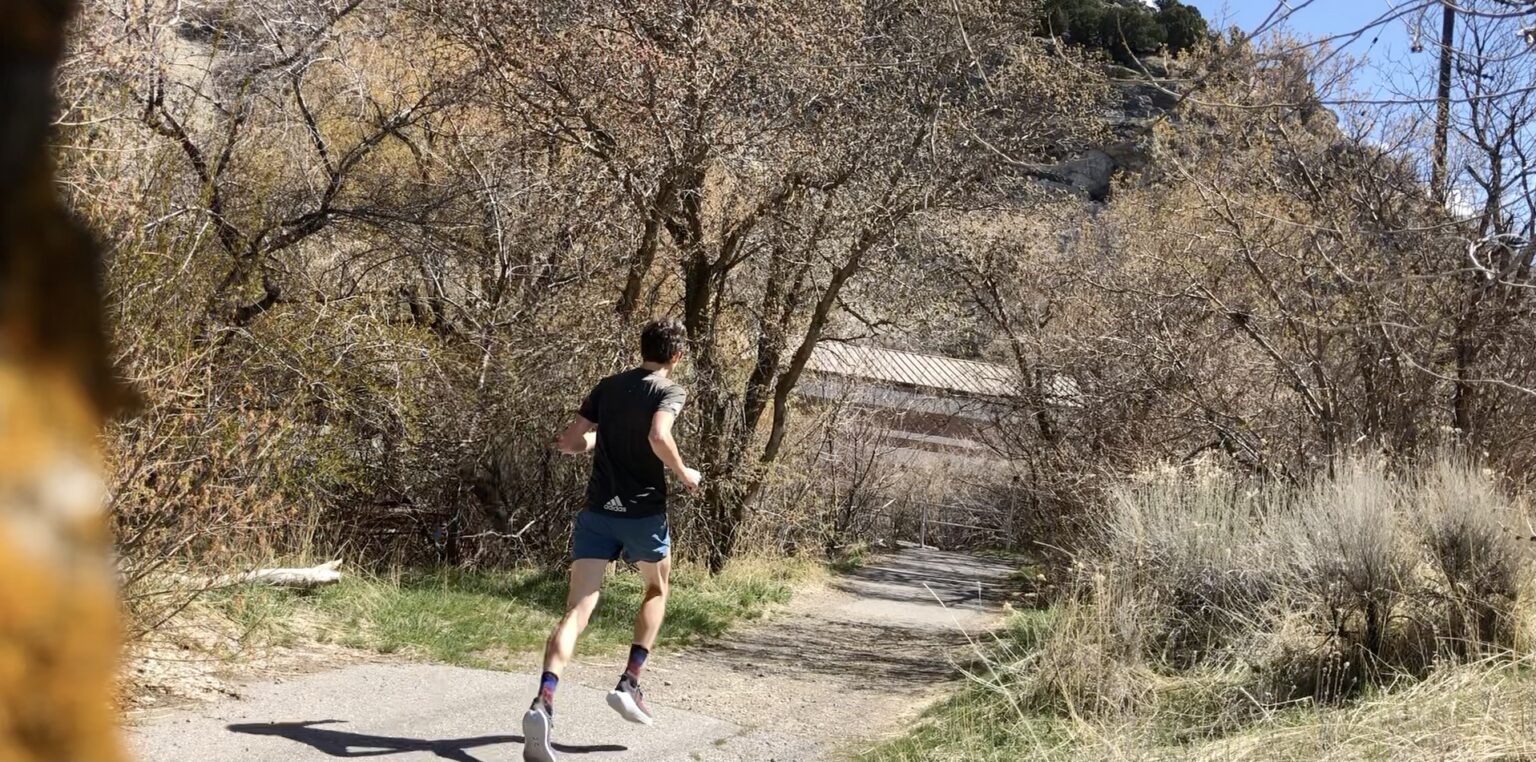
So glad I stumbled on your review. I am looking for a road version of the Speedgoat EVO 4. And I think Carbon X2 will fit nicely. I’m especially interested after developing a mild case of plantar fasciitis with Altra Torin 4. I don’t have issue with Altra Escalante Racer or the EVO4. Will see if the Carbon X2 helps provide good balance of energy return and dissipation as long as I do my part with proper form. Glad RoadRunner sports has 90 day trial.
Why can’t you guys make a good shoes
That come in wide?
Are you sure you got the right size? I got 9s, always wear 9 but my foot is really more of an 8-8.5. I get them a bit bigger cause I have a wide forefoot and the toebox on the Carbon X 2 has felt great. A bit narrow on the Rocket X for sure (feels comfy but I usually get a blister between my big toe and second toe in shoes that are too narrow) AND I’ve worn the Carbon X 2 for 50 miles. Great shoe, I think it gets better with distance! I think the durable outsole definitely holds up better than the Rincon 1 and 2s (haven’t tried the 3 yet) since those were totally smushed after doing 50ish mile runs in them.